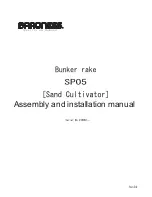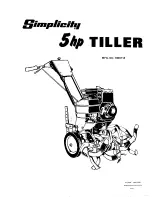
10
Totaline Environmentally Balanced Coil Cleaner Application
Equipment
• 2-1/2 gallon garden sprayer
• Water rinse with low velocity spray nozzle
Totaline Environmentally Balanced Coil Cleaner Application
Instructions
1. Proper eye protection such as safety glasses is recom
-
mended during mixing and application.
2. Remove all surface loaded fibers and dirt with a vacuum
cleaner as described above.
3. Thoroughly wet finned surfaces with clean water and a
low velocity garden hose, being careful not to bend fins.
4. Mix Totaline environmentally balanced coil cleaner in a
2
-
1/2 gallon garden sprayer according to the instructions
included with the cleaner. The optimum solution tempera
-
ture is 100°F.
NOTE: Do NOT USE water in excess of 130°F, as the enzymatic
activity will be destroyed.
5. Thoroughly apply Totaline environmentally balanced coil
cleaner solution to all coil surfaces including finned area,
tube sheets and coil headers.
6. Hold garden sprayer nozzle close to finned areas and apply
cleaner with a vertical, up-and-down motion. Avoid spraying
in horizontal pattern to minimize potential for fin damage.
7. Ensure cleaner thoroughly penetrates deep into finned
areas. Interior and exterior finned areas must be thor
-
oughly cleaned. Finned surfaces should remain wet with
cleaning solution for 10 minutes. Ensure surfaces are not
allowed to dry before rinsing. Reapply cleaner as needed
to ensure 10-minute saturation is achieved.
8. Thoroughly rinse all surfaces with low velocity clean
water using downward rinsing motion of water spray noz
-
zle. Protect fins from damage from the spray nozzle.
Evaporator Coil
CLEANING THE EVAPORATOR COIL
1. Turn unit power off. Install lockout tag. Remove evapora
-
tor coil access panel.
2. If economizer or two-position damper is installed, remove
economizer by disconnecting Molex
1
plug and removing
mounting screws.
3. Slide filters out of unit.
4. Clean coil using a commercial coil cleaner or dishwasher
detergent in a pressurized spray canister. Wash both sides
of coil and flush with clean water. For best results, back-
flush toward return-air section to remove foreign material.
Flush condensate pan after completion.
5. Reinstall economizer and filters.
6. Reconnect wiring.
7. Replace access panels.
THERMOSTATIC EXPANSION VALVE (TXV)
All 48JC units have a factory-installed nonadjustable thermo
-
static expansion valve (TXV). The TXV is a bi-flow, bleed port
expansion valve with an external equalizer. The TXVs are spe
-
cifically designed to operate with Puron
®
refrigerant. Use only
factory-authorized TXVs.
TXV Operation
The TXV is a metering device that is used in air conditioning
and heat pump systems to adjust to the changing load condi
-
tions by maintaining a preset superheat temperature at the out
-
let of the evaporator coil.
The volume of refrigerant metered through the valve seat is de
-
pendent upon the following:
1. Superheat temperature is sensed by cap tube sensing bulb
on suction tube at outlet of evaporator coil. This tempera
-
ture is converted into pressure by refrigerant in the bulb
pushing downward on the diaphragm, which opens the
valve using the push rods.
2. The suction pressure at the outlet of the evaporator coil is
transferred through the external equalizer tube to the
underside of the diaphragm.
3. The pin is spring loaded, which exerts pressure on the
underside of the diaphragm. Therefore, the bulb pressure
works against the spring pressure and evaporator suction
pressure to open the valve. If the load increases, the tem
-
perature increases at the bulb, which increases the pressure
on the top side of the diaphragm. This opens the valve and
increases the flow of refrigerant. The increased refrigerant
flow causes the leaving evaporator temperature to
decrease. This lowers the pressure on the diaphragm and
closes the pin. The refrigerant flow is effectively stabilized
to the load demand with negligible change in superheat.
Replacing TXV
1. Recover refrigerant.
2. Remove TXV support clamp using a 5/l6-in. nut driver.
3. Remove TXV using a wrench and an additional wrench on
connections to prevent damage to tubing.
4. Remove equalizer tube from suction line of coil. Use file
or tubing cutter to cut brazed equalizer line approximately
2 inches above suction tube.
5. Remove bulb from vapor tube inside cabinet.
6. Install the new TXV using a wrench and an additional
wrench on connections to prevent damage to tubing while
attaching TXV to distributor.
7. Attach the equalizer tube to the suction line. If the coil has
a mechanical connection, then use a wrench and an addi
-
tional wrench on connections to prevent damage. If the
coil has a brazed connection, use a file or a tubing cutter to
remove the mechanical flare nut from the equalizer line.
Then use a new coupling to braze the equalizer line to the
stub (previous equalizer line) in suction line.
8. Attach TXV bulb in the same location where the original
(in the sensing bulb indent) was when it was removed,
using the supplied bulb clamps. See Fig. 17.
9. Route equalizer tube through suction connection opening
(large hole) in fitting panel and install fitting panel in place.
10. Sweat the inlet of TXV marked “IN” to the liquid line.
Avoid excessive heat which could damage the TXV valve.
Use quenching cloth when applying heat anywhere on
TXV.
CAUTION
UNIT DAMAGE HAZARD
Failure to follow this caution may result in accelerated
corrosion of unit parts.
Harsh chemicals, household bleach or acid or basic cleaners
should not be used to clean outdoor or indoor coils of any kind.
These cleaners can be very difficult to rinse out of the coil and
can accelerate corrosion at the fin/tube interface where
dissimilar materials are in contact. If there is dirt below the
surface of the coil, use the environmentally balanced coil
cleaner.
1. Molex is a registered trademark of Molex, Inc.
Summary of Contents for 48JC04-06
Page 15: ...15 Fig 26 Condenser Fan Assembly Screw Pattern Sequence 1 2 3 4 5 NO SCREW Blank Tab...
Page 30: ...30 Fig 52 Integrated Gas Controller IGC Board RED LED STATUS...
Page 64: ...64 APPENDIX D WIRING DIAGRAMS Fig B 48JC 04 06 Control Wiring Diagram...
Page 65: ...65 APPENDIX D WIRING DIAGRAMS Fig C 48JC 04 06 Power Wiring Diagram 208 230 460 3 60...











































